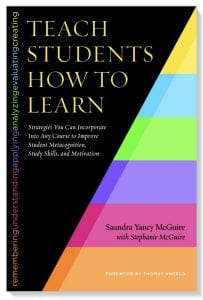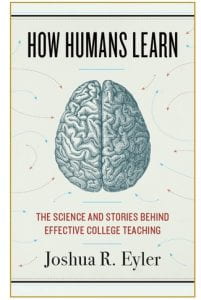The science of learning is a growing area of research in cognitive neuroscience. Understanding how the brain processes and stores information is critical in developing effective pedagogies for students at all levels. Scientists are particularly interested in understanding student learning at the college level and enhancing academic success. Sarah Rose Cavanaugh’s The Spark of Learning examines the role emotions play in the classroom and seeks to integrate cognitive and affective science to maximize motivation and learning. Saundra Yancy McGuire’s Teach Students How to Learn catalogs a range of research-based learning strategies coupled with evidence of their effectiveness in the classroom based on the author’s personal experience as a college professor. Joshua R. Eyler’s How Humans Learn analyzes the science of learning from an evolutionary perspective and offers insight into why certain pedagogical strategies are more effective than others. All three books explore the science of learning and introduce a broad spectrum of effective learning strategies and practical applications for the classroom. However, the books vary in how heavily they focus on the science behind these learning strategies.
Cavanaugh’s The Spark of Learning explores the intersection of emotions and cognitive learning. The author posits that students’ ability to learn is profoundly impacted by both positive and negative emotions, and the goal of teachers is to harness these emotions to  maximize student learning. The book is divided into two parts: the foundations of affective science, followed by suggestions of how to use affective science in the classroom. In the first part, the author explains the neuroscience of emotions and why emotional responses influence attention, memory, and motivation. In the second part, she describes how student learning can be impacted by the classroom environment, what teachers can do to provide safety and support for their students, and what to do when things go wrong.
maximize student learning. The book is divided into two parts: the foundations of affective science, followed by suggestions of how to use affective science in the classroom. In the first part, the author explains the neuroscience of emotions and why emotional responses influence attention, memory, and motivation. In the second part, she describes how student learning can be impacted by the classroom environment, what teachers can do to provide safety and support for their students, and what to do when things go wrong.
Cavanaugh explains many complex theories in cognitive psychology and neuroscience with clear, comprehensible language that is simple enough for more novice readers. Her writing is captivating, and the way she describes the emotional landscape of students’ lives outside the classroom is particularly moving. She emphasizes the practice of empathy and consideration for young students who are experiencing many complicated emotions for the first time. The stress of transitioning into adulthood can be overwhelming for college students. High levels of stress and anxiety caused by many factors including the pressure to succeed in school, moving away from family and friends, financial burdens, new friendships and romantic relationships, poor sleep hygiene, physical illnesses, and mental health issues like depression and anxiety, can lead to decreased motivation and poor academic performance.
Cavanaugh also points out that stereotype threat can also be a source of stress and anxiety, especially for women and minorities in STEM. For example, women have been shown to perform worse on science and math tests when they are worried about fulfilling the common stereotype that women perform poorly in science and math. Practicing empathy and fostering an emotional connection with students can be effective in alleviating anxiety, and offering a safe space for those who are struggling can improve motivation, performance, and emotional health. The Spark of Learning explores the effects emotions have on student learning, and college professors would greatly benefit from considering the various sources of stress experienced by their students and from implementing the teaching strategies outlined in this innovative book.
Complementing Cavanaugh’s research into the connection between emotion and learning, McGuire’s Teach Students How to Learn aims to equip teachers with an abundance of research-based learning strategies centered around metacognition, motivation, and mindset. The author includes specific and practical classroom applications and provides evidence of their effectiveness with success stories from the author’s personal experience as a chemistry professor at Louisiana State University. The author explains that many students enter college not knowing how to learn, and the goal of teachers is to teach their students how to learn through using metacognitive learning strategies. She explains metacognition and the importance of mindset, then describes each learning strategy in exhaustive detail and provides numerous suggestions for both teachers and students.
One questionable aspect of the book is the repetitive storytelling that heavily emphasizes grades. These anecdotes are fundamentally problematic because they perpetuate the idea that high test scores serve as definitive proof of successful learning. This correlation is likely more representative of neurotypical students, ignoring neurodivergent students with test scores not representative of their actual learning capacity. For example, chemistry students with dyslexia may have difficulty with mathematical equations and unit conversion. For these students, the method used for teaching these concepts was critical for their success. In this case, teaching these concepts with the proportion method instead of the mathematical equation method had little effect on the performance of neurotypical students, but significantly improved the performance of dyslexic students (Kamińska-Ostęp & Gulińska, 2008). The need to change to a different teaching method that is more effective for all students in the classroom can be difficult to recognize when only focusing on students who achieved success using the current teaching method without needing any accommodations. Learning strategies that work for most students may be ineffective for a smaller and less noticeable group of students who may respond to another strategy.
Many educators, including Eyler, the author of How Humans Learn, reject the old grading model, as it favors competition over actual learning, stigmatizes failure (which is critical for learning), and leads to feelings of inadequacy. However, McGuire advocates for more frequent, low-stakes assignments that allow students to demonstrate their knowledge without the fear of failure. Also, these low stakes assignments provide early opportunities for students to receive feedback on their performance.
McGuire makes many claims about the success of her learning strategies, but the supporting evidence seems to be lacking, for she focuses on the success stories of individual students in her classroom, which may not be a fair representation of the success experienced by her other students. The other two books include research supporting many of her claims, and including this evidence could have made the book seem more credible. Though her stories may not satisfy readers looking for scientific explanation, McGuire is unquestionably an inspiring and competent educator. The book’s additional resources (including several ready-to-use presentations, a recorded lecture, and a companion book written for students entitled Teach Yourself How to Learn) are nothing short of impressive. As a whole, Teach Students How to Learn is an invaluable resource for teachers in higher education.
Adding to the perspectives of Cavanaugh and McGuire, Joshua Eyler’s How Humans Learn investigates human learning from an evolutionary perspective and uses research from cognitive neuroscience, developmental psychology, and anthropology to examine why some teaching strategies work while others don’t. In the introduction, Eyler explores how the definition of learning is complex and differs across disciplines. He explains that learning involves brain plasticity, can be intentional or implicit, and usually achieved through a process of asking, answering, and ultimately formulating new questions. Eyler posits that humans innately know how to learn, and the goal of teachers is to cultivate this natural ability by inspiring curiosity and giving attention and guidance to their students.
Eyler’s views on learning appear to contradict McGuire’s assertion that students do not know how to learn when they enter college. However, McGuire describes learning in the context of  ability to study and make grades that reflect academic success. If McGuire adopted Eyler’s definition of learning, it would be interesting to see if changing her concept to teaching students how to study would have any effect on her students’ motivation and mindset.
ability to study and make grades that reflect academic success. If McGuire adopted Eyler’s definition of learning, it would be interesting to see if changing her concept to teaching students how to study would have any effect on her students’ motivation and mindset.
Each chapter of How Humans Learn begins with recent scientific research related to the five key components of learning: curiosity, sociality, emotion, authenticity, and failure. The author then provides an explanation of how each component informs current pedagogical strategies, several suggestions of how to apply these strategies in the classroom, and finally, a bulleted summary of the key takeaways. The first chapter examines the role of intellectual curiosity in human learning. It begins with a story about the author’s curious six-month-old daughter and shifts to defining curiosity in terms of neuroscience and behavioral psychology. The author then shifts from the evolutionary development of human curiosity to the importance of curiosity in early stages of cognitive development. He then compares child learners and adult learners, explaining the parallels between patterns of increasing complexity seen in both the way children ask questions during conversations and the way adults move from novice to expert when learning a topic.
Eyler uses this mountain of evidence to support his argument: humans already know how to learn, and that natural learning process simply needs to be cultivated. He explains that curiosity diminishes during the years of school due to the increasing pressures and demands associated with growing up. The rest of the chapter explores different topics including anxiety, empathy, discussion-based pedagogies, and even more. This ambitious chapter could be a book on its own, and the organization of this diverse material is thoughtful and incredibly satisfying.
Eyler’s expertise in learning science and creative pedagogies is so incredible that discovering he has a Ph.D. in Medieval Literature is quite surprising. His science writing is clear, concise, and engaging. This book is an excellent tool in providing effective learning strategies for the classroom as well as thorough explanations of why those strategies work. How Humans Learn is a fascinating read for college educators and anyone interested in the science of learning.
All three authors lead by example and engage their readers using the same teaching strategies they recommend. They tie together concepts with personal examples, effectively demonstrating competence and credibility. They use humor and enthusiasm to capture interest and maintain the attention of the reader. Overall, Cavanaugh’s The Spark of Learning, McGuire’s Teach Students How to Learn, and Eyler’s How Humans Learn offer a unique and multifaceted perspective on learning science and serve as a valuable tool for teachers in higher education.
References
Cavanagh, S. R. (2016) The spark of learning: Energizing the college classroom with the science of emotion. West Virginia University Press.
Eyler, J. R. (2018) How humans learn: The science and stories behind effective college teaching. West Virginia University Press.
Kamińska-Ostęp, A., & Gulińska, H. (2008). Teaching Methods and Aids Assisting Dyslyxic Pupils in Learning Chemistry. Journal of Baltic Science Education. 7(3), 147-154.
McGuire, S. Y., & McGuire, S. (2015) Teach students how to learn: Strategies you can incorporate into any course to improve student metacognition, study skills, and motivation. Stylus Publishing, LLC.
Meredith Little received her MS in Biology from Georgia State University in Fall, 2022. This review essay was part of her Masters thesis.
